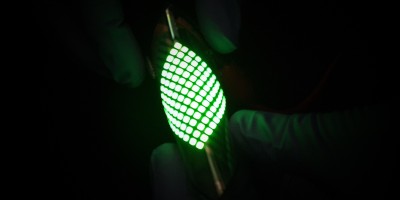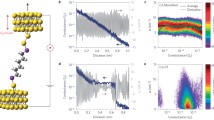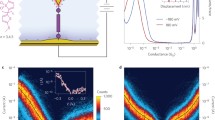Abstract
The ultimate target of molecular electronics is to combine different types of functional molecules into integrated circuits, preferably through an autonomous self-assembly process. Charge transport through self-assembled monolayers has been investigated previously, but problems remain with reliability, stability and yield, preventing further progress in the integration of discrete molecular junctions. Here we present a technology to simultaneously fabricate over 20,000 molecular junctions—each consisting of a gold bottom electrode, a self-assembled alkanethiol monolayer, a conducting polymer layer and a gold top electrode—on a single 150-mm wafer. Their integration is demonstrated in strings where up to 200 junctions are connected in series with a yield of unity. The statistical analysis on these molecular junctions, for which the processing parameters were varied and the influence on the junction resistance was measured, allows for the tentative interpretation that the perpendicular electrical transport through these monolayer junctions is factorized.






Similar content being viewed by others
References
Chen, F., Hihath, J., Huang, Z., Li, X. & Tao, N. J. Measurement of single-molecule conductance. Annu. Rev. Phys. Chem. 58, 535–564 (2007).
Venkataraman, L. et al. Single-molecule circuits with well-defined molecular conductances. Nano Lett. 6, 458–462 (2006).
Cui, X. D. et al. Reproducible measurement of single-molecule conductivity. Science 294, 571–574 (2001).
Cui, X. D. et al. Changes in the electronic properties of a molecule when it is wired into a circuit. J. Phys. Chem. B 106, 8609–8614 (2002).
Tao, N. J. Electron transport in molecular junctions. Nature Nanotech. 1, 173–181 (2006).
Akkerman, H. B. & de Boer, B. Electrical conduction through single molecules and self-assembled monolayers. J. Phys. Condens. Matter 20, 13001 (2008).
Porter, M. D., Bright, T. B., Allara, D. L. & Chidsey, C. E. D. Spontaneously organized molecular assemblies. 4. Structural characterization of n-alkyl thiol monolayers on gold by optical ellipsometry, infrared spectroscopy and electrochemistry. J. Am. Chem. Soc. 109, 3559–3573 (1987).
Love, J. C., Estroff, L. A., Kriebel, J. K., Nuzzo, R. G. & Whitesides, G. M. Self-assembled monolayers of thiolates on metals as a form of nanotechnology. Chem. Rev. 105, 1103–1169 (2005).
Vericat, C. et al. Surface characterization of sulfur and alkanethiol self-assembled monolayers on Au(111). J. Phys. Condens. Matter 18, R867–R900 (2006).
Wang, W., Lee, T. & Reed, M. A. Electron tunnelling in self-assembled monolayers. Rep. Prog. Phys. 68, 523–544 (2005).
Slowinski, K., Chamberlain, R. V., Miller, C. J. & Majda, M. Through-bond and chain-to-chain coupling. Two pathways in electron tunnelling through liquid alkanethiol monolayers on mercury electrodes. J. Am. Chem. Soc. 119, 11910–11919 (1997).
Kim, Y.-H., Tahir-Kheli, J., Schultz, P. A. & Goddard III, W. A. First-principles approach to the charge-transport characteristics of monolayer molecular-electronics devices: Application to hexanedithiolate devices. Phys. Rev. B 73, 235419 (2006).
Müller, K.-H., Effect of the atomic configuration of gold electrodes on the electrical conduction of alkanedithiol molecules. Phys. Rev. B 73, 045403 (2006).
de Boer, B. et al. Metallic contact formation for molecular electronics: Interactions between vapour-deposited metals and self-assembled monolayers of conjugated mono- and dithiols. Langmuir 20, 1539–1542 (2004).
Reed, M. A., Zhou, C., Muller, C. J., Burgin, T. P. & Tour, J. M. Conductance of a molecular junction. Science 278, 252–254 (1997).
Kim, T. W., Wang, G., Lee, H. & Lee, T. Statistical analysis of electronic properties of alkanethiols in metal–molecule–metal junctions. Nanotechnology 18, 315204 (2007).
Akkerman, H. B., Blom, P. W. M., de Leeuw, D. M. & de Boer, B. Towards molecular electronics with large-area molecular junctions. Nature 441, 69–72 (2006).
Bain, C. D. et al. Formation of monolayer films by the spontaneous assembly of organic thiols from solution onto gold. J. Am. Chem. Soc. 111, 321–335 (1989).
Akkerman, H. B. et al. Self-assembled-monolayer formation of long alkanedithiols in molecular junctions. Small 4, 100–104 (2008).
Wang, G., Kim, T.-W., Lee, H. & Lee, T. Influence of metal–molecule contacts on decay coefficients and specific contact resistances in molecular junctions. Phys. Rev. B 76, 205320 (2007).
Seminario, J. M. & Yan, L. Ab initio analysis of electron currents in thioalkanes. Int. J. Quantum Chem. 102, 711–723 (2005).
Landau, A., Kronik, L. & Nitzan, A. Cooperative effects in molecular conduction. J. Comp. Theor. Nanosci. 5, 535–544 (2008).
Tomfohr, J. K. & Sankey, O. F. Complex band structure, decay lengths and Fermi level alignment in simple molecular electronic systems. Phys. Rev. B 65, 245105 (2002).
Tomfohr, J. K. & Sankey, O. F. Theoretical analysis of electron transport through organic molecules. J. Chem. Phys. 120, 1542–1554 (2004).
Acknowledgements
We acknowledge financial support from the EU projects NAIMO (NMP4-CT-2004-500355). The work of E.C.P.S. forms part of the research program of the Dutch Polymer Institute (DPI) project no. 516. The work of H.B.A. and A.J.K. was financially supported by the Zernike Institute for Advanced Materials and NanoNed, a national nanotechnology program coordinated by the Dutch Ministry of Economic Affairs. The work in Mons is partly supported by the Interuniversity Attraction Pole IAP 6/27 Program of the Belgian Federal Government ‘Functional supramolecular systems (FS2).’ J.C. is a research fellow of FNRS. The work of S.P. and G.L. is supported by Fondazione Cariplo—Project TOLEDO. We acknowledge J.H.M. Snijders, C. van der Marel and H. Nulens for the XPS and AFM measurements, R.G.R. Weemaes for the FIB-TEM analysis, R. Schroeders for technical assistance, and N. Willard for fruitful discussions.
Author information
Authors and Affiliations
Corresponding author
Supplementary information
Supplementary Information
Supplementary Information (PDF 2318 kb)
Rights and permissions
About this article
Cite this article
Van Hal, P., Smits, E., Geuns, T. et al. Upscaling, integration and electrical characterization of molecular junctions. Nature Nanotech 3, 749–754 (2008). https://doi.org/10.1038/nnano.2008.305
Received:
Accepted:
Published:
Issue Date:
DOI: https://doi.org/10.1038/nnano.2008.305
- Springer Nature Limited
This article is cited by
-
Two layers are better than one
Nature Materials (2020)
-
Concepts in the design and engineering of single-molecule electronic devices
Nature Reviews Physics (2019)
-
Nonlinear and Nonsymmetric Single-Molecule Electronic Properties Towards Molecular Information Processing
Topics in Current Chemistry (2017)
-
Conformation-driven quantum interference effects mediated by through-space conjugation in self-assembled monolayers
Nature Communications (2016)
-
Flexible molecular-scale electronic devices
Nature Nanotechnology (2012)





